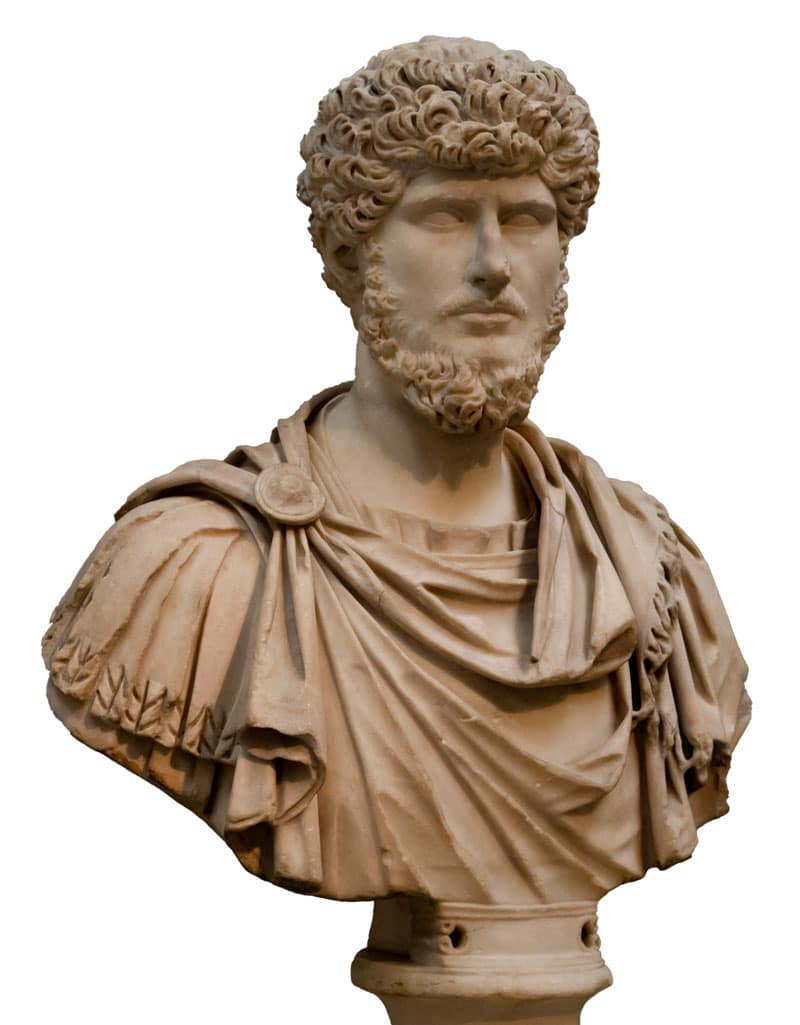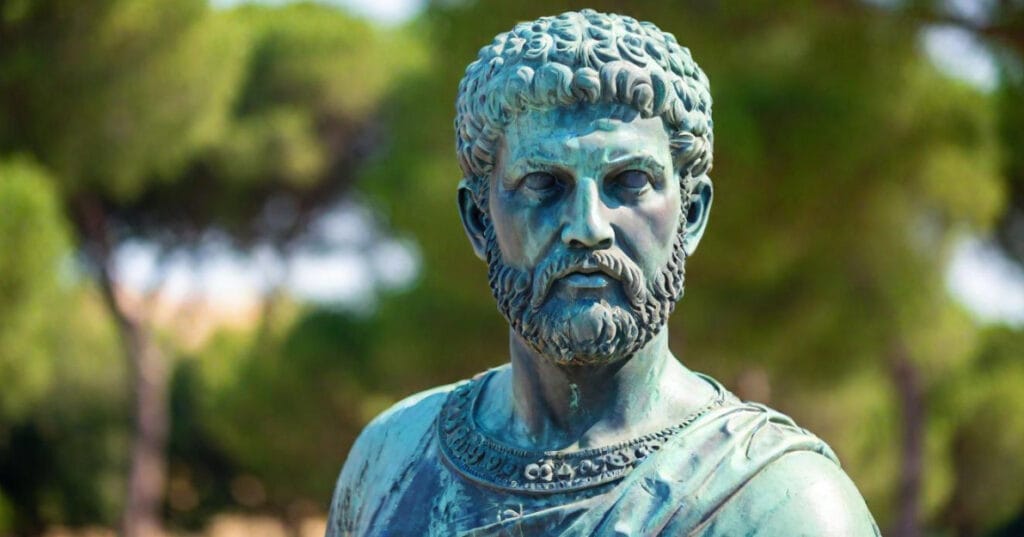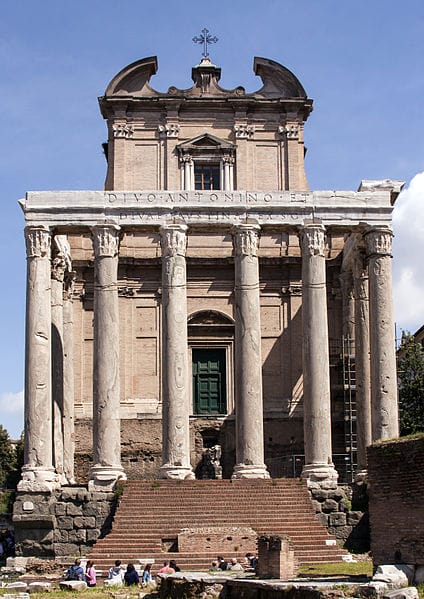Life: AD 130 – 169

- Name: Lucius Ceionius Commodus
- Born on 15 December AD 130 in Rome.
- Consul AD 154, 161, 167.
- Became co-emperor on 7 March AD 161.
- Wife: (1) Annia Aurelia, (2) Galeria Lucilla (one daughter).
- Died at Altinum, Jan/Feb AD 169.
Emperor Lucius Verus, with the birthname Lucius Ceionius Commodus, was born on 15 December AD 130, the son of a man of the same name whom Hadrian adopted as his successor. When his father died, Hadrian adopted Antoninus Pius instead with the requirement that he, in turn, should adopt Marcus Aurelius (Hadrian’s nephew) and the boy Ceionius.
This adoption ceremony took place on 25 February AD 138, with Ceionius only being seven years old. When Antoninus Pius died in 161 AD, Marcus Aurelius and Lucius Verus became joint emperors, fulfilling Antoninus’ wishes. However, it’s worth noting that Lucius Verus’ position was somewhat subordinate to Marcus Aurelius, who was his senior and had a more prominent role in governance.
The transition of power from Antoninus Pius to Marcus Aurelius and Lucius Verus was relatively smooth, as it followed the established tradition of adoption within the imperial family. Upon assuming the throne, Lucius Verus faced various challenges, including conflicts on the Roman frontiers, particularly against the Parthian Empire in the east. His reign was marked by military campaigns, including the Parthian War and conflicts with Germanic tribes along the Danube frontier.
Despite his military successes, Lucius Verus is often overshadowed by Marcus Aurelius, who is remembered as one of the “Five Good Emperors” of Rome. Lucius Verus’ reign was cut short by his death in 169 AD, after which Marcus Aurelius continued to rule as sole emperor until his death in 180 AD.
Lucius Verus – Preparing to Became the Emperor
Throughout Antoninus’ reign, he was to remain in the shadow of the emperor’s favorite, Marcus Aurelius, who was being groomed to hold office. If Marcus Aurelius was granted the office of consul at 18 years of age, he had to wait until he was 24.

If the Senate had had its way, then on the death of emperor Antoninus in AD 161, only Marcus Aurelius would have acceded to the throne. But Marcus Aurelius simply insisted that his step-brother be made his imperial colleague, according to the will of both emperors Hadrian and Antoninus. And so Ceionius became emperor under the name chosen for him by Marcus Aurelius, Lucius Aurelius Verus. For the first time, Rome should be under the joint rule of two emperors, creating a precedent frequently repeated after that.
Lucius Verus was tall and goodlooking. Unlike emperors Hadrian, Antoninus, and Marcus Aurelius, who had made wearing beards fashionable, Verus grew his beard to the length and breadth of a ‘barbarian. He is said to have taken great pride in his hair and beard and, at times, even to have sprinkled gold dust on it in order to further enhance its blonde color. He was an accomplished public speaker and also a poet and enjoyed the company of scholars.
Though so too was he an ardent fan of chariot racing, publicly backing the ‘Greens,’ the horse racing faction supported by the poor masses of Rome. Further, he was also very interested in physical activities such as hunting, wrestling, athletics, and gladiatorial combat.
The Antonine Period
The Antonine period, spanning the reigns of the emperors Antoninus Pius, Marcus Aurelius, and Lucius Verus, was marked by cultural vibrancy and intellectual flourishing within the Roman Empire. This era saw significant developments in literature, philosophy, art, and architecture.
Literature flourished during the Antonine period, with notable authors such as Marcus Aurelius himself, whose “Meditations” remains a classic of Stoic philosophy. Other prominent literary figures of the time included the historian Dio Cassius and the biographer and philosopher Philostratus. Philosophy also experienced a resurgence, particularly Stoicism, which had a profound influence on Marcus Aurelius and his reign. Stoic principles emphasizing virtue, rationality, and acceptance of fate were reflected in the philosophical works of the period. Art and architecture thrived during the Antonine period, with significant building projects and artistic endeavors across the empire.

The era witnessed the construction of magnificent structures like the Temple of Antoninus and Faustina in Rome and the Antonine Wall in Britain. Roman art during this time showcased a blend of classical forms with innovative techniques and motifs influenced by the diverse cultures within the empire. The Antonine period also saw advancements in engineering, particularly in the construction of roads, aqueducts, and public buildings, contributing to the infrastructure and urban development of the Roman Empire.
Cultural exchange and interaction flourished during this time, facilitated by the extensive trade networks and the Roman Empire’s vast territorial expanse. The empire’s multicultural nature fostered the exchange of ideas, customs, and artistic styles, enriching the cultural landscape of the Antonine period. Overall, the Antonine period stands out as a time of intellectual and artistic flourishing, characterized by a rich tapestry of literature, philosophy, art, and architecture that contributed to the cultural legacy of the Roman Empire.
Military Commander or a Gladiator?
In AD 161, the Parthians ousted the king of Armenia, who was a Roman ally, and launched an attack on Syria. While Marcus Aurelius stayed in Rome, Verus was given command of the army against the Parthians. But he arrived in Syria only 9 months later, in AD 162. This was partly due to illness but partly also, many thought, due to being too careless and preoccupied with his pleasure to show greater haste.
Once at Antioch, Verus remained there for the rest of the campaign. The leadership of the army was left entirely to the generals, and it is said, at times, to Marcus Aurelius back in Rome. Meanwhile, Verus followed his fancies, trained as a gladiator and bestiarius (animal fighter), and wrote frequently to Rome inquiring about his horses. Verus also found himself charmed by an eastern beauty called Panthea, for whom he even shaved off his beard in order to please her.
Some historians harshly criticize Verus’ evident lack of interest in the very campaign he was sent to oversee. But others point to his lack of military experience. It might well have been that, knowing himself incompetent at military affairs, Verus left things to those who might know better.
By the year AD 166, Verus’ generals had brought the campaign to an end, the cities of Seleucia and Ctesiphon having been captured in AD 165. Verus returned to Rome in triumph in October AD 166, but together with Verus’ troops, came back to Rome with a serious plague. The epidemic would devastate the Empire, raging for 10 years across the empire from Turkey to as far as the Rhine.

Death of Emperor Lucius Verus
Successive attacks on the Danube frontier by Germanic tribes soon forced the joint emperors to take action again. In the autumn of AD 167, they set out for the north, leading their troops. But hearing of their coming was enough reason for the barbarians to withdraw, with the emperors only having reached as far as Aquileia in northern Italy.
Verus sought to return to the comforts of Rome, yet Marcus Aurelius thought that, rather than merely turn back, one should make a show of force north of the Alps in order to reassert Roman authority. After having crossed the Alps and then having returned back to the Aquileia in late AD 168, the emperors prepared to pass the winter in the town.
But then plague broke out among the soldiers, so they set out for Rome despite the winter cold. But they hadn’t journeyed for long when Verus – most likely affected by the disease – had a fit and died at Altinum (Jan/Feb AD 169). Verus’ body was carried back to Rome and laid to rest in the Mausoleum of Hadrian, and he was deified by the senate.

People Also Ask:
What are some interesting facts about Lucius Verus?
Lucius Verus oversaw a successful military campaign against the Parthians between 162 and 166 CE. However, while in the east, his legions contracted smallpox and brought it back to Rome. This triggered the Antonine Plague, which killed millions of Romans and severely weakened the empire.
Was Lucius Verus a good or bad emperor?
The Nervan and Antonine dynasty consisted of the “Five Good Emperors” (Nerva, Trajan, Hadrian, Antoninus Pius, and Marcus Aurelius) together with Lucius Verus, who ruled jointly with Marcus Aurelius, and Commodus the son of Marcus Aurelius.
Was Lucius the father of Maximus?
Ridley Scott stated that Crowe had favored a fantasy element in bringing Maximus back to life, while Scott believed that a grounded, historical approach was the better option. While he believed the film would not be made, he confirmed the plan to reveal that Lucius Verus is the son of Maximus and Lucilla.
What happened to Lucius Verus?
After initial involvement in the Marcomannic Wars, Lucius Verus fell ill and died in 169. He was deified by the Roman Senate as the Divine Verus (Divus Verus).

Historian Franco Cavazzi dedicated hundreds of hours of his life to creating this website, roman-empire.net as a trove of educational material on this fascinating period of history. His work has been cited in a number of textbooks on the Roman Empire and mentioned on numerous publications such as the New York Times, PBS, The Guardian, and many more.
